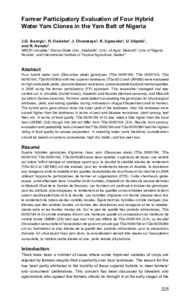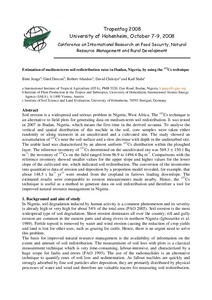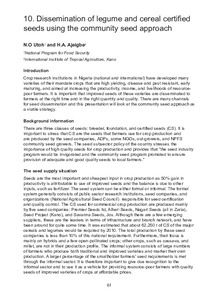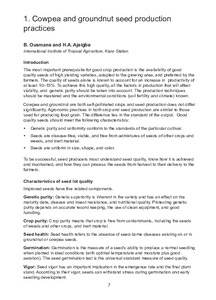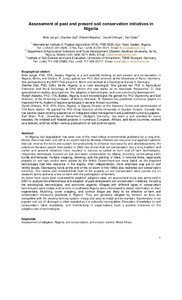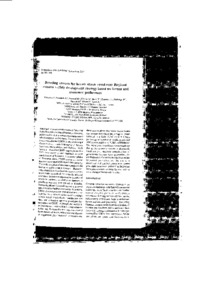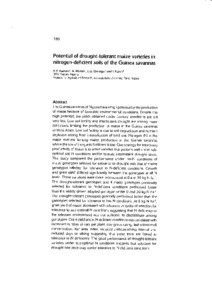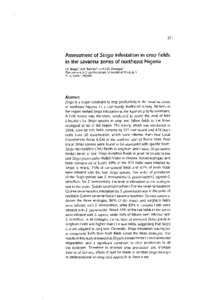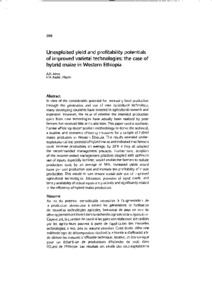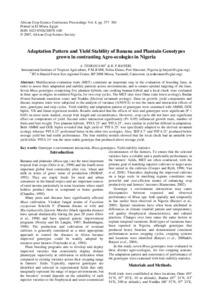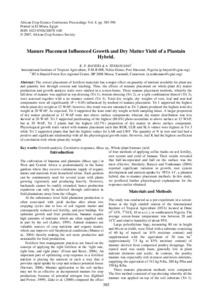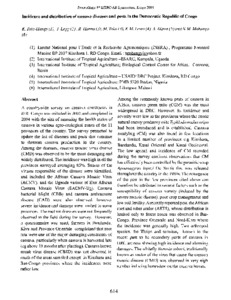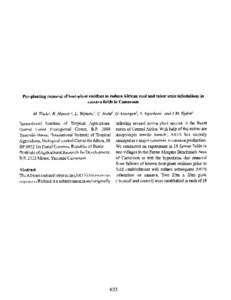Welcome to the International Institute of Tropical Agriculture Research Repository
Conference Documents: Recent submissions
Now showing items 501-520 of 597
-
Farmer participatory evaluation of four hybrid water yam clones in the yam belt of Nigeria
(2009)Four hybrid water yam (Dioscorea alata) genotypes (TDa 00/00194, TDa 00/00103, TDa 00/00104, TDa 00/00363) with two superior landraces (TDa 92-2 and UM 680) were evaluated for high and stable yields, pest and disease resistance, and acceptable food and market qualities in 2006 using the farmer participatory (FP) approach. This researcher managed trial was carried out in Umudike (humid forest), Abakaliki and Nsukka (derived savanna), and Makurdi (southern Guinea savanna). ... -
Estimation of medium-term soil redistribution rates in Ibadan, Nigeria, by using the 137 Cs technique
(2008)Soil erosion is a widespread and serious problem in Nigeria, West Africa. The 137 Cs technique is an alternative to field plots for generating data on medium-term soil redistri bution. It was tested in 2007 in Ibadan, Nigeria, which means the firs t time in the derived savanna. To analyse the vertical and spatial distribution of this nuclide in the soil, core samples were taken either randomly or along transects in an uncultivated and a cultivated ... -
Assessment of past and present soil conservation initiatives in Nigeria
(2008)In Nigeria, soil degradation has been one of t he most critical environmental problems for a long time. Hence, there has been and still is an urgent need t o develop effective soil resource management system s that can reverse the trend and sustain soil product ivity to enhance food security and alleviate povert y. An extensive literature search that started in 2006 ha s shown that soil conservation has a long tradition and earlier and present initiatives have resulted in va rious ... -
Sweetpotato crop improvement in sub-Saharan Africa and future challenges
(International Society of Tropical Root Crops, 2007)In sub-Saharan Africa region, most sweetpotato are produced from diverse landraces that have constant turnover. The preference for high dry matter is between 28 to 35%. CIP breeding strategy for the past 15 years has been to collect, characterize, and conserve farmers' varieties; evaluate and distribute the best performers regionally. It has also emphasised population development through crosses and systematic screening with partners using participatory methods. Key stages of breeding programme ... -
Breeding cassava for brown streak resistance: regional cassava variety development strategy based on farmers and consumer preferences
(International Society of Tropical Root Crops, 2007)Cassava is an important food crop in the East African coastal lowlands. However, yields are low due to various reasons amongst which are pests and diseases. Cassava brown streak virus disease (CBSD) is one of the major diseases of economic importance in Kenya, Tanzania, Mozambique and Malawi. Yield losses attributed to CBSD ranging from 49-74% have recently been reported in some coastal areas of Tanzania. It is estimated that in Tanzania alone, CBSD causes economic losses of more than USD 16,000,000 ... -
Effects of sole cropping, intercropping and rotation with legume trap-crops on striga control and maize grain yield in farmers' fields in the Guinea savannas
(International Institute of Tropical Agriculture, 2007)On-farm trials were conducted in 2001 to 2003 in the northern Guinea savanna of Nigeria to evaluate integrated Striga hermonthica control methods under farmer-managed conditions. These included intercropping a Striga-resistant maize variety with cowpea (Vigna unguiculata L.) and also cropping this maize in rotation with legume trap-crops - soybean (Glycine max (L) Merr.) and cowpea. Intercropping Striga-tolerant maize vaeirty, Acr. 97 TZL Comp. 1-W, with cowpea or rotating it with the soybean ... -
A review of NARES-IARC-Donor collaboration to develop demand-driven technologies for improved maize production in West and Central Africa
(International Institute of Tropical Agriculture, 2007)Maize researchers in West and Central Africa (WCA) established the West and Central Africa Collaborative Maize Research Network (WECAMAN) in 1987 to tackle maize production constraints too formidable for individual national programs to overcome. The National Agricultural Research Systems (NARS) that were relatively strong for specific research areas were funded by the Network to generate improved technologies, which were evaluated in on-farm trials and adopted or adapted in other member countries ... -
Potential of drought-tolerant maize varieties in nitrogen-deficient soils of the Guinea savannas
(International Institute of Tropical Agriculture, 2007)The Guinea savannas of Nigeria have a high potential for the production of maize because of favorable environmental conditions. Despite this high potential, the yields obtained under farmers' conditions are still very low. Low soil fertility and intermittent drought are among major constraints limiting the production of maize in the Guinea savannas of West Africa. Low soil fertility is due to soil degradation and nutrient depletion arising from intensification of land use. Nitrogen (N) is the major ... -
Assessment of striga infestation in crop fields in the savanna zones of northeast Nigeria
(International Institute of Tropical Agriculture, 2007)Striga is a major constraint to crop productivity in the savanna zones of northeast Nigeria. In a community livelihood survey, farmers in the region ranked Striga infestation as the topmost priority constraint. A field survey was, therefore, conducted to assess the level of field infestation by Striga species in crop and fallow fields in the three ecological zones of the region. The survey, which was conducted in 2004, covered 935 fields comprising 459 compounds and 476 bush fields from 30 ... -
Unexploited yield and profitability potentials of improved varietal technologies: the case of hybrid maize in Western Ethiopia
(International Institute of Tropical Agriculture, 2007)In view of the considerable potential for increasing food production through the generation and use of new agricultural technology, many developing countries have invested in agricultural research and extension. However, the issue of whether he intended production gains from new technologies have actually been realized by poor farmers has received little or no attention. This peruseda stochastic frontier efficiency decomposition methodology to derive the technical, allocative, and economic ... -
Adaptation pattern and yield stability of banana and plantain genotypes grown in contrasting agro-ecologies in Nigeria
(African Crop Science Society, 2007)Multilocation evaluation trials (MET) constitute an important step in the evaluation of breeding lines, in order to assess their adaptation and stability patterns across environments, and to ensure optimal targeting of the lines. Seven Musa genotypes comprising five plantain hybrids, one cooking banana hybrid and a local check were evaluated in three agro-ecologies in southern Nigeria, for two crops cycles. The MET sites were Onne (rain forest ecology), Ibadan (Forest-Savannah transition zone) and ... -
Manure placement influenced growth and dry matter yield of a plantain hybrid
(African Crop Science Society, 2007)The correct placement of fertilizer materials has a major effect on quantity of nutrient available for plant use and quantity lost through erosion and leaching. Thus, the effects of manure placement on whole-plant dry matter production and growth analysis traits were studied in a screen-house. Three manure placement methods, whereby they full dose of manure was applied as top-dressing (Trt 2), or a split combination thereof (Trt 3), were assessed together with a no manure control (Trt 4). Total ... -
Evaluation of advanced peanut breeding lines for resistance to late leaf spot and rust
(American Peanut Research and Education Society, 2007) -
Incidence and distribution of cassava diseases and pests in the Democratic Republic of Congo
(International Society For Tropical Root Crops-Africa Branch, 2007)A countrywide survey on cassava constraints in D.R. Congo was initiated in 2002 and completed in 2004 with the aim of assessing the health status of cassava in various agro-ecological zones of the 11 provinces of the country. The survey permitted to update the list of diseases and pests that continue to threaten cassava production in the country. Among the diseases, cassava mosaic virus disease (CMD) was observed to be the most damaging and widely distributed. The incidence was high in all ... -
Biological control of cassava green mite in Tanzania
(International Society For Tropical Root Crops-Africa Branch, 2007)The cassava green mite Mononychellus tanajoa (Bondar) (Acari: Tetranychidae) is one of the most important pests of cassava, a main staple food crop in Tanzania. The International Institute of Tropical Agriculture (ETA) in collaboration with the Tanzania National Biological Control P r o m (NBCP) launched in 1998 the biological control campaign against cassava green mite in Tanzania with the release of the neotropicd phytoseiid predator Z)phlodromallus aripo DeLeon (Acari: Phytoseiidae), which had ... -
Distribution and abundance of cassava pests in Tanzania with a note on the spiralling whitefly
(International Society For Tropical Root Crops-Africa Branch, 2007)Two surveys were conducted in Tanzania in May- June 2003 and June-August 2004 to determine the incidence and severity of several cassava arthropod pests including cassava green mite, cassava mealybug, spiralling whitefly, Bemisia spp., cassava scale, red mite, Zonocerus elegans, and several species of termites. Cassava green mite densities were relatively low except in the Lake region in 2004. The introduced phytoseiid predator of cassava green mite Typhlodromalus aripo was found in all regions, ... -
Distribution, incidence and severity of cassava diseases and pests in Mozambique
(International Society For Tropical Root Crops-Africa Branch, 2007)Two countrywide surveys were conducted in April-May and May-June 2004 throughout the cassava growing belt of Mozambique including several provinces: Gaza, Inhambane, Sofala, Manica, Zambezia, Nampula and Cabo Delgado. Both surveys were planned to assess the distribution, incidence and damage severity of diseases and pests that affect cassava production in Mozambique. Using the methodology developed by the International Institute of Tropical Agriculture (IITA), 202 and 175 cassava fields between ... -
Pre-planting removal of host-plant residues to reduce African root and tuber scale infestations in cassava fields in Cameroon
(International Society For Tropical Root Crops-Africa Branch, 2007)The African root and tuber scale (ARTS) Stictococcus vayssierei Richard is a subterranean insect originally infesting several native plant species in the forest zones of Central Africa. With help of the native ant Anoplolepis tenella Santchi, ARTS has recently emerged as a major constraint to cassava production. We conducted an experiment in 18 farmer fields in two villages in the Forest Margins Benchmark Area of Cameroon to test the hypothesis that removal from fallows of known host-plant residues ...

